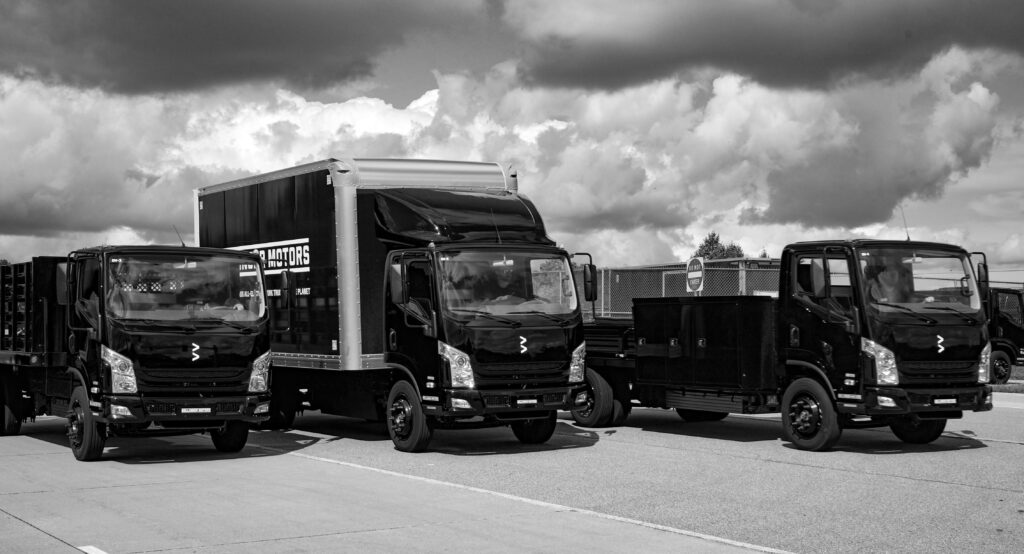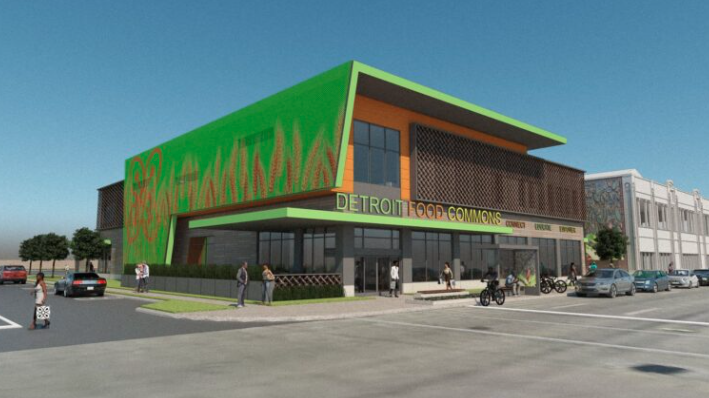Commercial Fleet Vehicle’s Evolution to Electrification

Bollinger Motors is an electric vehicle manufacturer focused on Class 4 and Class 5 trucks. Founded in 2015, the company initially set out to develop off-road electric vehicles but later pivoted to commercial fleet electrification, seeing a gap in the medium-duty truck market. Now headquartered in Oak Park, Michigan, Bollinger is majority-owned by California-based Mullen Automotive (Nasdaq: MULN). SBN Detroit interviewed Jim Connelly, the company’s Chief Revenue Officer, to discuss the challenges and opportunities within the Class 4 and Class 5 electric truck market, the considerations driving fleet electrification, and the broader implications for sustainability and economic growth in the region. Q: How did Bollinger Motors get started, and what led the company into the Class 4 and 5 truck market? A: Robert Bollinger founded Bollinger Motors in 2015 in upstate New York with the goal of developing a rugged, off-road vehicle for his farm that didn’t rely on gas. He and a small team of engineers started experimenting in his garage. As things progressed, Robert saw a gap in the commercial truck space – there were virtually no electric options in the Class 4, 5, and 6 segments. With government incentives accelerating EV adoption, the opportunity to focus on the commercial market became clear. Bollinger moved operations to Oak Park in 2017, tapping into the automotive engineering and manufacturing expertise in Detroit. Q: What is the driving force behind the development of Class 4 and 5 trucks, and how does this market function? A: The commercial vehicle sector has been expanding rapidly, particularly with the rise of last-mile delivery services and the increasing demand for residential delivery. Class 4 and 5 trucks are utilized across several industries, including landscaping, telecommunications, and delivery services. These versatile vehicles play a key role in urban and regional transportation. Electrification makes perfect sense for this market. Most Class 4 and 5 vehicles operate locally, returning to a central depot each evening, which simplifies charging logistics. The predictable routes and relatively moderate daily mileage make them ideal candidates for EV adoption. Q: What are the main factors driving businesses to transition to electric trucks at this size? A: Sustainability goals are a major motivator. Large corporations are looking to reduce their carbon footprint, and transitioning their fleets from gas and diesel to electric clearly aligns with their environmental objectives. Cost savings are a key factor as well. Fuel economy improvements, lower maintenance costs, and federal and state incentives make electric fleet adoption financially appealing. Since these vehicles are driven extensively, reducing fuel costs and minimizing maintenance expenses significantly lower the total cost of ownership over time. Q: What are the biggest challenges and opportunities in establishing EV adoption in this segment? The biggest challenge is infrastructure development. Companies need to build charging infrastructure to support EV fleets, which can be a major hurdle. Another challenge is driver familiarity. Drivers are used to gas and diesel vehicles, so transitioning to EVs can be disruptive. We intentionally designed the truck’s cab and controls to be similar to traditional vehicles. When it comes to opportunities, the market is wide open. Q: How does Bollinger’s partnership with EO Charging support fleet electrification? A: While many companies are eager to transition to electric fleets, most fleet managers have spent their careers managing gas and diesel vehicles. The shift to EVs requires new knowledge about charging infrastructure, vehicle compatibility, and grid capacity – areas that can cause angst. EO Charging provides end-to-end solutions, assessing customers’ facilities, infrastructure, and utility needs. They work alongside us to ensure that everything is in place – from hardware installation to liaising with utility companies – so businesses can confidently move forward with EV adoption. Q: What has the response from fleet operators been since Bollinger launched sales last fall? A: The response has been very positive. At the recent NTEA Work Truck Show, we participated in ride-and-drive events, where industry leaders and fleet managers had the opportunity to test our vehicles. Many have since expressed strong interest in long-term test drives, which we are now scheduling. We’ve also established a growing dealer network, with over 50 locations nationwide and are continuing to expand. Discussions with additional dealer groups indicate that demand for electric commercial trucks is rising steadily. Q: How do these trucks compare to diesel alternatives in cost and emissions? A: The total cost of ownership varies depending on several factors, including miles driven, fuel prices, vehicle lifespan, and upfitting requirements. We use a tool developed by Argonne National Laboratory at the University of Chicago, which allows businesses to calculate the payback period and emissions reductions for their specific use case. While EVs have a higher upfront cost, they become more cost-effective over time due to fuel savings, reduced maintenance, and substantial government incentives. Speaking of incentives, the federal government offers a $40,000 tax credit for Class 4 EVs under the Inflation Reduction Act. Certain states, such as California, provide additional incentives of up to $60,000 per vehicle, meaning businesses can receive up to $100,000 in incentives per truck. These incentives make early EV adoption much more financially viable. Many states now offer additional grants and rebates as well. We have a dedicated team that helps customers navigate these incentives, ensuring they maximize available savings. Q: What role does Bollinger’s Michigan headquarters play in the future of EV truck production? A: Robert Bollinger always knew that to scale, he needed to be in Detroit – the automotive capital of the world. Southeast Michigan provides access to a highly skilled workforce, manufacturing expertise, and a network of suppliers and engineers that is unmatched anywhere else in the country. We see ourselves as more than just an EV company – we are an automotive company. Being headquartered in Michigan allows us to merge cutting-edge technology with traditional automotive craftsmanship, ensuring we produce world-class electric trucks that meet the needs of commercial fleets today and into the future. Be sure to subscribe to our newsletter for regular updates on sustainable business practices in and around Detroit.
African American-Led Grocery to Open Soon in Detroit

The Detroit People’s Food Co-op – projected to open in February at 8324 Woodward Ave. in Detroit’s North End – is an African-American-led, community-owned grocery cooperative. It seeks to address the issue of food insecurity, educate the community about nutrition and sustainability, support local businesses, and pump investment back into the area. Malik Yakini is the cofounder and executive director of the Detroit Black Community Food Security Network, the nonprofit organization that led the formation of the co-op, and serves on the co-op’s board. SBN Detroit spoke to Yakini about the co-op’s vision and sustainability goals. Q: Tell me about Detroit People’s Food Co-op. A: The Detroit People’s Food Co-op is a grocery store that’s in the development stage and is owned by member-owners. It’s projected to open in February 2024 and will have a full line of groceries, including produce sourced locally and regionally. It will carry value-added products that are produced by local entrepreneurs, and as much as possible we will hire staff from Detroit. The most significant part of a co-op is that it is not a corporation coming into Detroit to profit. It’s people in the community banding together to co-own the store so that the community reaps the benefits and profits. Currently, we have 1,958 member-owners. In this pre-opening stage, the member-owners make a lot of the decisions and shape the direction and culture of the store. The member-owners elect six of the nine members of the co-op’s board of directors, and DBCFSN appoints the other three. In June, the board contracted with an interim general manager who is tasked with getting the final pre-opening tasks done, coordinating the opening, and making sure that the store is positioned for success. The board hopes to hire a permanent general manager in the next few months. The other benefit of being a member-owner is the opportunity to share in the profits of the store. In any year the store is profitable, member-owners get a percentage. Q: What inspired the co-op? A: It grew out of discussions within the Detroit Black Community Food Security Network. When the network was founded in 2006, one of the goals was to support existing co-ops and to create this new food co-op. So, this has been percolating for 17 years. It grew out of the desire of members of the network to push back against extractive economic practices we see in Black communities within the food realm. There is only one Black-owned grocery store in Detroit – Linwood Fresh Market – and that is very recent. For a city that has an African American population of 80%, to have other ethnic groups owning almost all of the retail food outlets in the city and extracting those profits from the city just isn’t right I don’t want to overgeneralize. Some of the stores are doing a good job at community partnerships and some are not. But the desire is to push back against an economy where others come in and set up stores and use the profits for their communities and families. We want to keep the profits and decisions here in our community. A co-op is one of the best ways to contribute toward a circular economy. Q: Why do you think the co-op is critical from a business perspective? A: The co-op model is an important model that has historically been used by Blacks and others marginalized by the mainstream economy. It broadens the ownership base and by doing that, those member-owners provide some of the financing for the business as well as receive some of the profits. So it’s a model that is more accessible to low- and moderate-income community members who don’t have access to the capital. Q: Does this create job opportunities for those in the community? A: Yes. We are expecting the grocery store to create more than 40 new jobs. Above the store, DBCFSN will operate a banquet hall and kitchen facilities that will create more. An important piece of the kitchen facilities is that they will be available for rental, which we hope will inspire food entrepreneurs to step into this arena, and those doing it to scale up their businesses. So yes, the vision is to create specific jobs at the store and to stimulate new and existing food businesses. Q: What is the economic impact on the community? A: I can’t give specific dollar amounts, but generally what happens when a business like this opens, it creates new jobs in the community. And now you have more people in the community with income being spent in the community. We are expecting that in this way the presence of the co-op will stimulate the economy in the area. We are also already seeing an increase in property values, which is a mixed blessing. We want to revitalize this community, which has seen distress, but at the same time, we need to make sure that development happens in an equitable way and doesn’t push out existing residents. This is a dilemma we are faced with. Q: Do you think this acts as an example for others in Southeast Michigan to replicate? A: One of the things we know is that Detroit is in some ways the canary in the coal mine. Detroit is an example of what happens as the economy shifts from industrial to more information-based. We are acutely aware that Detroit is being watched by the world. So as we develop this and other programs, we are certainly creating a model that’s being watched globally, so we move with that awareness. I hope this model is replicated around the world. Q: How will the co-op educate the community about sustainability? A: An important part of the co-op will be community education. We are concerned about nutrition and health and also the health of the planet because they are bound together. So we have a number of activities that will be geared toward educating community members about issues related to the food system, how the


